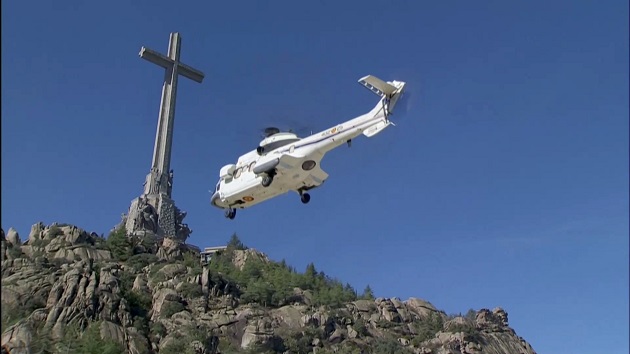Remains of Spanish dictator Franco exhumed from state basilica
“This decision marks an end to the moral insult that the public glorification of a dictator constitutes”, said the President of Spain, Pedro Sánchez. Under Franco, evangelicals were isolated, silenced and incarcerated.
MADRID · 24 OCTOBER 2019 · 19:51 CET

The remains of Spanish dictator Francisco Franco has been moved by helicopter, from the underground basilica of the Valley of the Fallen, to a cemetery near Madrid, where his wife was buried in 1988.
The exhumation followed a yearlong judicial battle between the Spanish government and the relatives of Franco, who had sought to reverse the decision.
On Tuesday, Spain’s Supreme Court ruled in favour of exhuming the body, and unanimously rejected the Franco family’s demand that his remains be moved to the Almudena Cathedral in Madrid .
Only a few people have been allowed to attend the exhumation. They include the Justice Minister, Dolores Delgado, in her role as first notary of the country, an expert in forensics, a Roman Catholic priest, and 22 descendants of Francisco Franco.
Media were excluded, but around 500 accredited reporters from 17 countries were near the site, to cover the event.
Some 300 far-right falangist supporters protested nearby the basilica.
MORE THAN 33,000 BURIED IN THE VALLEY OF THE FALLEN
The Valley of the Fallen, which is maintained with state funds, is one of Europe’s largest mass graves. More than 33,000 people were buried there after the Spanish Civil War, including those who fought for Franco, and others who sided with his Republican opponents.
The government’s intention is to reconvert the monumental memorial and Roman Catholic basilica into a neutral space, to promote reconciliation.
SÁNCHEZ: “THE END TO THE MORAL INSULT OF THE GLORIFICATION OF A DICTATOR”
“This decision marks an end to the moral insult that the public glorification of a dictator constitutes. We are taking another step towards the reconciliation that can only exist in the democracy and the freedom we all share”, the interim President of Spain, Pedro Sánchez, said on Thursday afternoon.
Sánchez recently told the United Nations General Assembly that Spain was taking the action because “no enemy of democracy deserves a place of worship or institutional respect”.
THE NEED TO “HEAL THE WOUNDS IN A HEALTHY WAY”
“Moving the remains of Franco should have been the last chapter and final closure of transcendental period, in which investigation, analysis and a deep social reflection would have created spaces of dialogue in which all sensibilities could have expressed themselves and listened to others”, Protestant history expert Evangelina Sierra told Spanish news website, Protestante Digital after the approval of the exhumation.
According to Jaume Llenas, Coordinator of the Graduate Bible Groups (GBG, in Spanish) and former Secretary General of the Spanish Evangelical Alliance, “the Valley of The Fallen is a symbolic place where we could start. But later it will be necessary to continue with the common graves of the war and the post-war, and the return to the families of the remains of those who were killed, so that they have a chance to close the wounds and bury their relatives with dignity”.
“Everything we do as a society will be part of our history, and we will be judged for it. As Christians, what is transcendental is to be capable of heal the wounds in a healthy way. We must sit beside those who suffered”, Sierra pointed out.
FROM DICTATORSHIP TO DEMOCRACY
In 1936, Franco lead a rebellion against a leftist republican government, unleashing three years of civil war. After his victory, he governed for 36 years with a strong right-wing ideology.
After the death of Franco in 1975, political parties agreed to put the war and the Franco era behind them, in the interest of unity and rebuilding. It then started a time known as “la Transición” (The Transition), which led the country to its current democracy.
A Historical Memory Law, passed in 2007 by the socialist government at the time, which aimed to recognised the war victims on both sides, and to remove Francoist monuments and symbols from public places.
Furthermore, the state-funded Royal Academy of History officially defined Franco as a dictator in 2015.
PERSECUTION AND ISOLATION OF EVANGELICALS
Since Franco’s victory, until the late sixties, many Spanish Protestants were incarcerated or even executed for confessing their faith.
In 1965, private Protestant meetings to pray, sing and study the Bible were approved, but were only legal if there were less than 20 people. In the public spaces, only Catholic ceremonies were allowed.
“Our parents and grandparents resisted the political persecution and harassment, with undoubted courage, in the rural and urban congregations”, as well as “social isolation in the workplace and schools, or the closing of places where they gathered to worship”, X. Manuel Suárez, Secretary General of the Spanish Evangelical Alliance, explained.
LOST OPPORTUNITIES
During the Transition, “the door was opened for us, but we were unable to understand that we had a crucial message for the society, ignoring that Western democracy was built upon the Protestant thinking and values”, Suárez pointed out.
“We should have brought our voice to the political arena, to give principles to the new born democracy, but we did not dare to do it, we had the complex of a minority and were content with just being tolerated”, he added.
Published in: Evangelical Focus - europe - Remains of Spanish dictator Franco exhumed from state basilica
